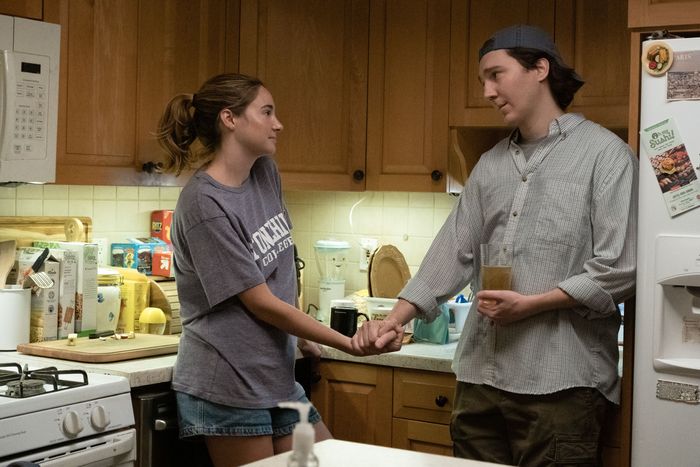
They made a movie about the GameStop short squeeze already? Yes, they did: Craig Gillespie’s Dumb Money hits theaters in late September, 32 months after a ragtag group of online investors attempted to get rich by targeting the Wall Street titans betting against the retail chain. (For comparison’s sake, the movie All the President’s Men came out more than three years after the events depicted in the film.) How do you make a major studio comedy so quickly — especially when that comedy has 12 major characters and over 250 scenes that take place across the country?
Speaking to Vulture the week before Dumb Money’s TIFF premiere, Gillespie (whose previous credits include Lars and the Real Girl and I, Tonya) broke down the fevered pace of his latest film’s production. “We moved very quickly, but I actually love that,” he says. “If you have to go on instinct, it gives you less time to second-guess.”
1. Have an Intimate Knowledge of Your Subject
Gillespie didn’t just follow the GameStop story on the news. He had a first-hand view of the emotional turmoil Reddit investors went through because he was living with one. His 24-year-old son, who’d come to live with him during lockdown, had been involved since the early days. “It was one of those COVID things that happened, the alienation of everybody. He’d be up till three in the morning, getting up at 6 a.m. to look at the markets before they opened,” the director says. “We got to live through the whole blow-by-blow in real time: the exhilaration, the frustration, the anger, the outrage. I don’t think I would’ve been interested had I not been on that journey with him.”
The son got out at the right time; Gillespie, who’d mostly stuck to index funds, did not. He bought GME the day before Robinhood froze trading, and the price collapsed. “I’m one of the people who lost money on GameStop,” he says, laughing. (Though thanks to the film, he probably still netted out positive in the end.)
2. Assume Someone Else Is Working on the Same Thing
MGM pounced on the GameStop story early, securing the rights to Ben Mezrich’s book The Antisocial Network mere weeks after the stock peaked and before the book itself had been written. At the time, Gillespie was working with writers Rebecca Angelo and Lauren Schuker Blum on a film about Chippendale’s, which fell apart when Hulu’s Welcome to Chippendales got there first. “It seems to be the way in Hollywood that there’s multiple attempts going on” for any real-life story, he says. The day after that project collapsed, Angelo and Blum sent Gillespie their Dumb Money script; he thought they did “a beautiful job.” Having been burned once before, everyone knew that time was of the essence. “There was a certain momentum, and we moved very quickly throughout this whole process,” Gillespie says. “It’s always a house of cards that could fall at any moment.”
3. Lock in Your Lead
A typical studio film might get 12 weeks of preproduction. Dumb Money had six. Much of that time was spent nailing down the character of Keith Gill, the Redditor who kicked off the stock rally, who would be played by Paul Dano. “Once we had Paul, that set the tone of the film,” Gillespie said. He looked to Dano’s performance in 2016’s Swiss Army Man as a touchstone: “There was a joy and enthusiasm and naïvety in that, and you could see in the postings of Keith Gill.”
The real Gill has since retreated from the spotlight, so Gillespie and Dano spent weekends trying to unpack him as a character. “There’s a photograph of him outside of his house, right around the time he got subpoenaed — what happened when he walked into the house? We’d try to figure out what the dynamic was, then we’d call Rebecca and Lauren and be like, ‘Okay, we need a scene like this,’” Gillespie says. “We kept adding scenes, and they rewrote very quickly.”
Gillespie has built up an unofficial repertory company of actors like Seth Rogen and Sebastian Stan, who both starred in I, Tonya and quickly signed on to this project. And the script kept evolving as other actors joined the cast: They couldn’t hire Broadway’s Anthony Ramos, who plays a GameStop employee, without having him dance at least once. In casting, they were even luckier than they realized: The film became America Ferrera’s follow-up to Barbie, and the ensemble also features two actors from Oppenheimer, Dane DeHaan and Olivia Thirlby, who bring to Dumb Money the same intensity they did to the creation of the atomic bomb.
4. Go to New Jersey
With only 31 shooting days on the schedule, production needed a base that could double for Massachusetts, Michigan, and Texas. They found it just across the Hudson. Besides the fact that New Jersey could convincingly play vast swathes of the country, was there anything else that helped it stand out? “The tax break that you get is very appealing,” Gillespie notes.
5. Don’t Be Afraid to Improvise
Gillespie shot Dumb Money with his longtime collaborator, cinematographer Nicolas Karakatsanis. “We have a rhythm where we can move very quickly,” he says. “We’re hyperefficient in terms of setup time; the lighting’s very simple. Once we’re in it, we can change around and go very quickly.” Seth Rogen shot his part of the film in four days. “At the end of it, I thought, I’m kind of tired. I checked the camera report, and we’d done 84 setups on the last day and 93 setups on the second-to-last day.”
That may sound like a rush job, but Gillespie says the simplicity of the setups helped keep things loose. “We just try and get as much time with the actors in front of the camera as possible,” he says. “It gives us the chance to try different things, and the actors get to improvise as well.” One scene with Ramos’s character and his mother originally ended on an ominous line about day-trading being like a drug. “It was landing on a very heavy note,” Gillespie recalled, so he added a beat where Ramos sniffed an imaginary line off his phone. “The way she responded to that, and he responded to her, suddenly you get this dynamic of a family and how they can tease each other. We were always keeping nimble and hunting for how to push scenes a little bit.”
6. Cover, Cover, Cover
However big the metaphorical significance of the GameStop short squeeze, there was still no getting around the fact that Dumb Money was going to have a lot of scenes of people staring at their phones. “It can get very dull, very quickly,” Gillespie says. “To keep it engaging, you need these inserts of hands on mouses, cameras, feet jiggling — all this extra stuff to give it some momentum.”
Coverage was key. About half the film was shot with two cameras at once, which helped keep everything running on schedule. The size of the cast complicated matters further. One pivotal dinner scene, where Keith Gill and his brother (Pete Davidson) inform their working-class parents that Gill is now a millionaire, had to be shot in two hours owing to Davidson’s Bupkis commitments. This could only be done by adding a third camera. “We really blocked it out,” Gillespie says. “The beauty of a scene like that is it’s messy and everyone’s talking over each other. Pete can be very spontaneous — every take’s a different reaction, and everyone’s rolling with that.” Shooting the scene became “a beautiful dance,” Gillespie says. “I never felt rushed, even though we did it so quickly.”
7. Let Memes Do the Hard Work for You
After the film wrapped, Gillespie screened many, many rough cuts for friends and family. The biggest note was to cut down on the exposition. “It started to feel like homework — what they’re trading, how options work, what the stock prices are,” he says. He realized that footage of telegenic people concisely explaining everything to laypeople already existed: He and editor Kirk Baxter could simply cut in actual news broadcasts. The same went for the memes. He didn’t have to figure out a way to dramatize thousands of Redditors and TikTokers taking up arms against Wall Street. He could have a team sift through internet ephemera until they found the perfect GIFs and TikToks, which appear as interstitial bits. “They’d send us 60 options of memes, and we’d start cutting them together.” Memes were fair use, but each of the TikToks had to be cleared with the individual creators. “There’s a whole world of legality. I was happy I was not on that team,” Gillespie says.
8. Figure Out How to Handle COVID
Dumb Money takes place in late 2020 and early 2021, which presents a unique dramaturgical hurdle — characters would have to spend a significant amount of their screen time wearing masks. “We had to come up with devices simply to see their faces,” Gillespie says. Food helped: They gave people beverages, so they’d have to lower their masks to take a sip; for America Ferrera’s nurse, they’d set a scene during her lunch break.
At other times, they leaned into it. Ramos’s character works in a GameStop, so his mask became a shorthand for the power dynamic between him and his boss, who rigorously enforces protocol. And in the scenes set in the hedge-fund palaces of Florida, masks symbolize the upstairs-downstairs divide. Seth Rogen’s hedge-fund CEO never wears one, while his army of domestic servants are always masked up. “Everything was calculated through that lens of wealth disparity,” Gillespie says.
You may recall that another major news event happened in January 2021. The movie only glancingly mentions the insurrection at the Capitol, but in the editing room, Gillespie did find a way to touch on the emotional scars left over from the trauma of 2020, an inescapable part of the context of the time. “It was such an intense moment for people they don’t need a lot to be reminded of what it was,” Gillespie says. Anchoring it is a speech from Dano about everything regular people lost over the pandemic. “It’s a testament to Paul’s performance that he can take you to this emotional place while he’s sitting there in a kitty-cat shirt with a Santa hat on.”
More From the Toronto International Film Festival
- Without Gore or Violence, This Serial-Killer Thriller Creeps Into Your Soul
- Miyazaki Didn’t Lose a Step
- We’re Going to Be Talking About American Fiction All Awards Season Long





